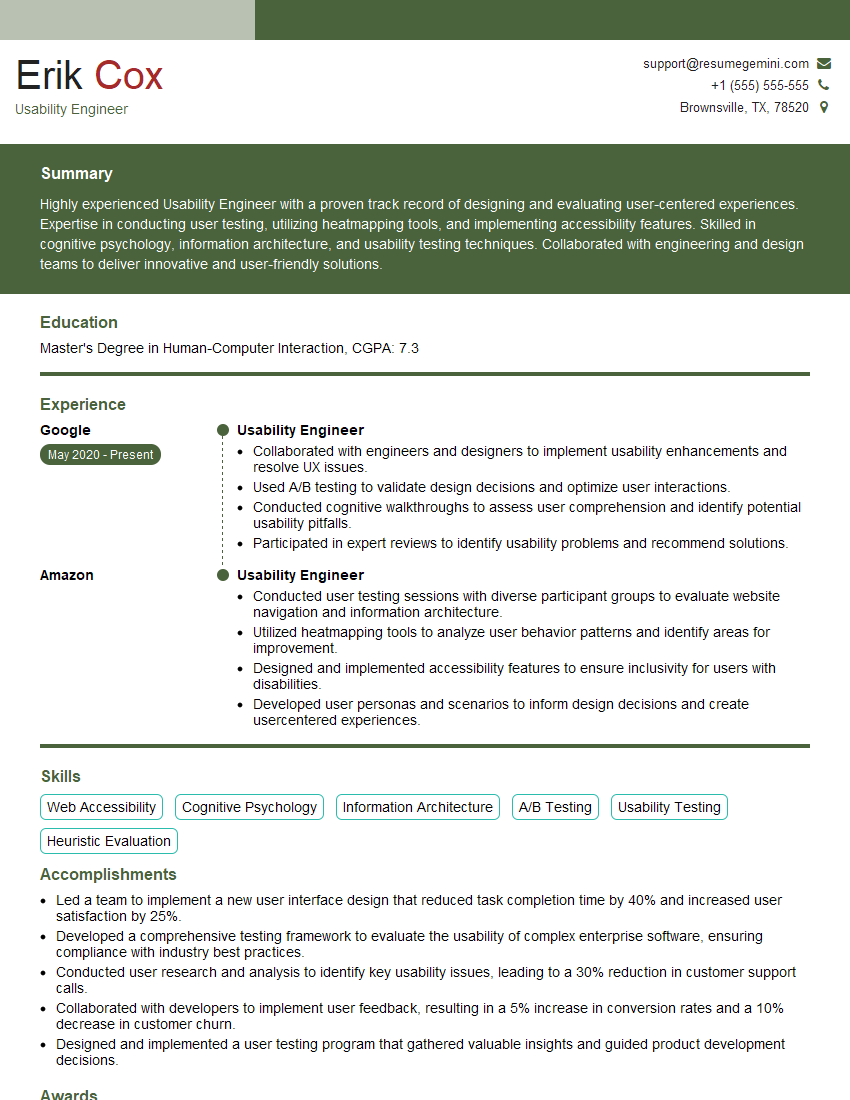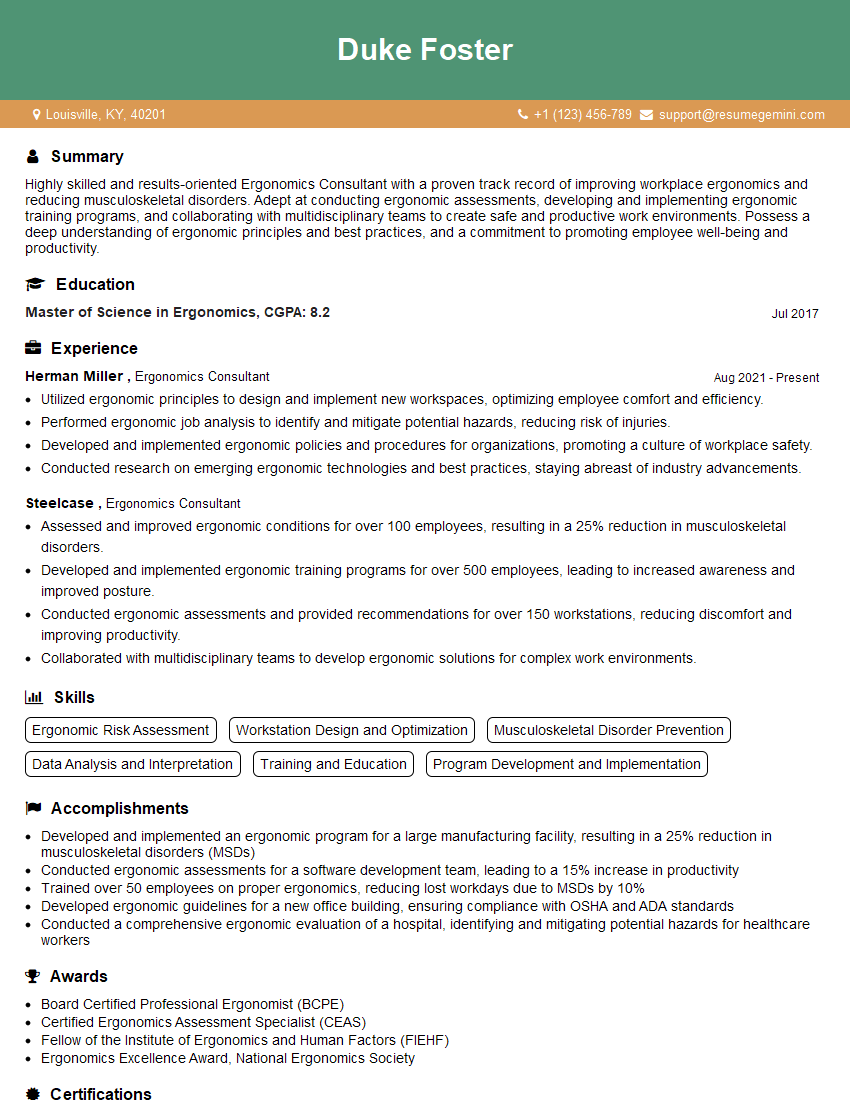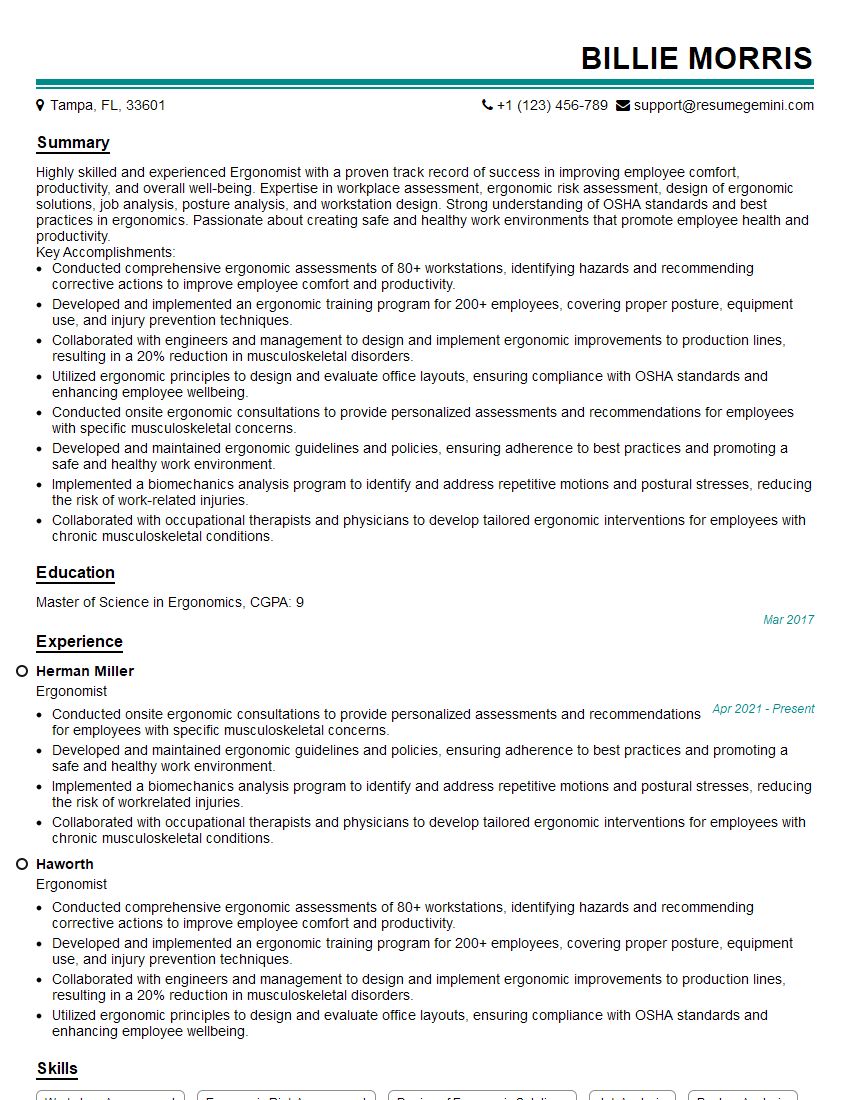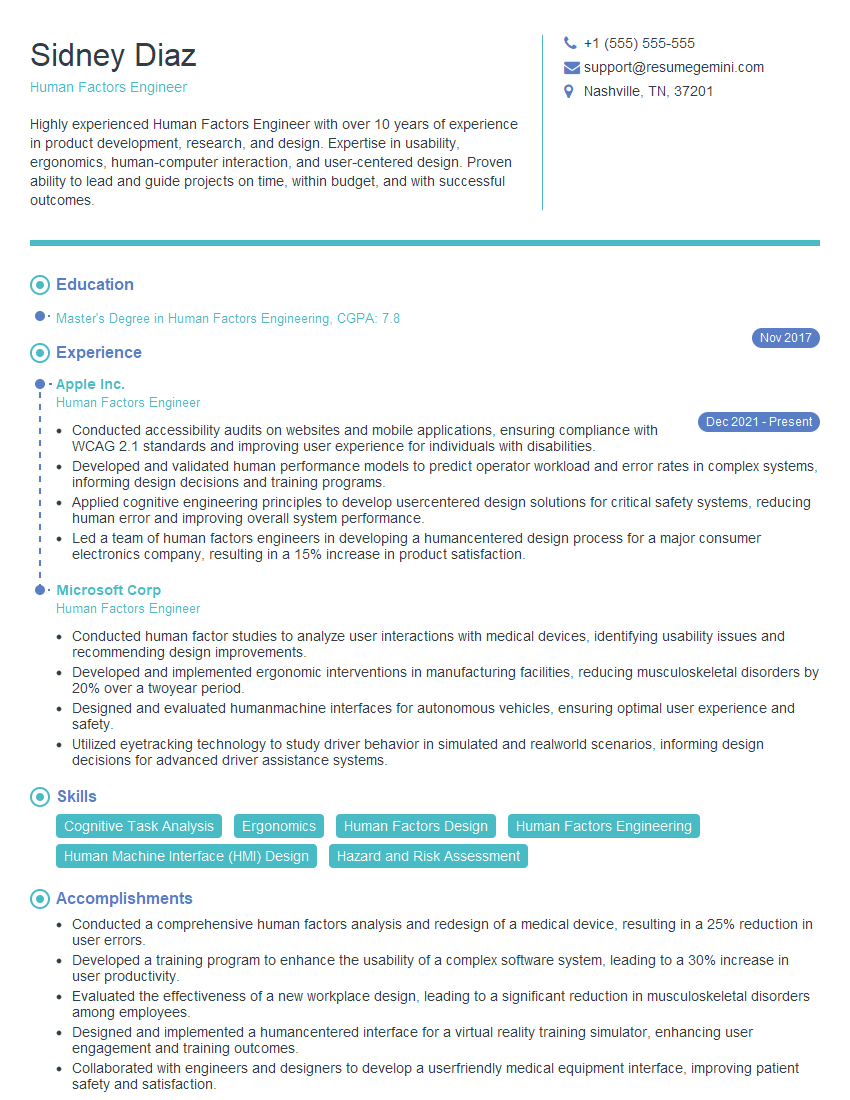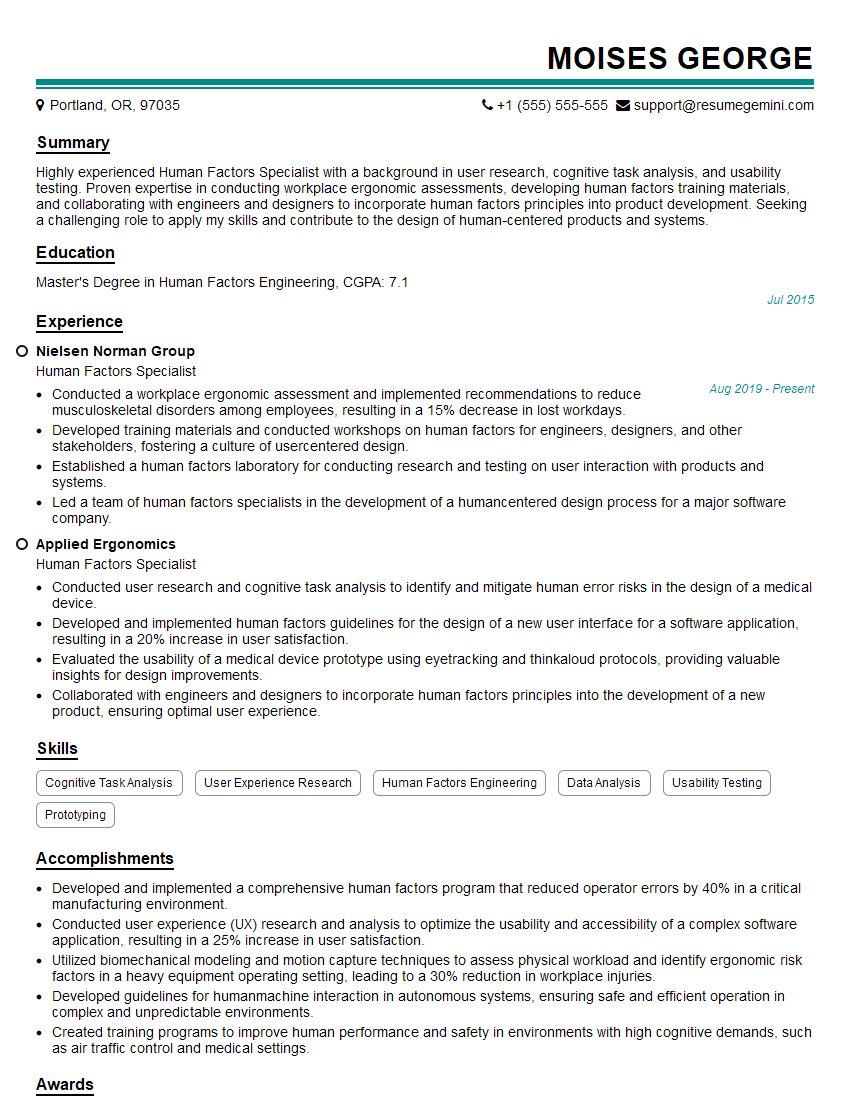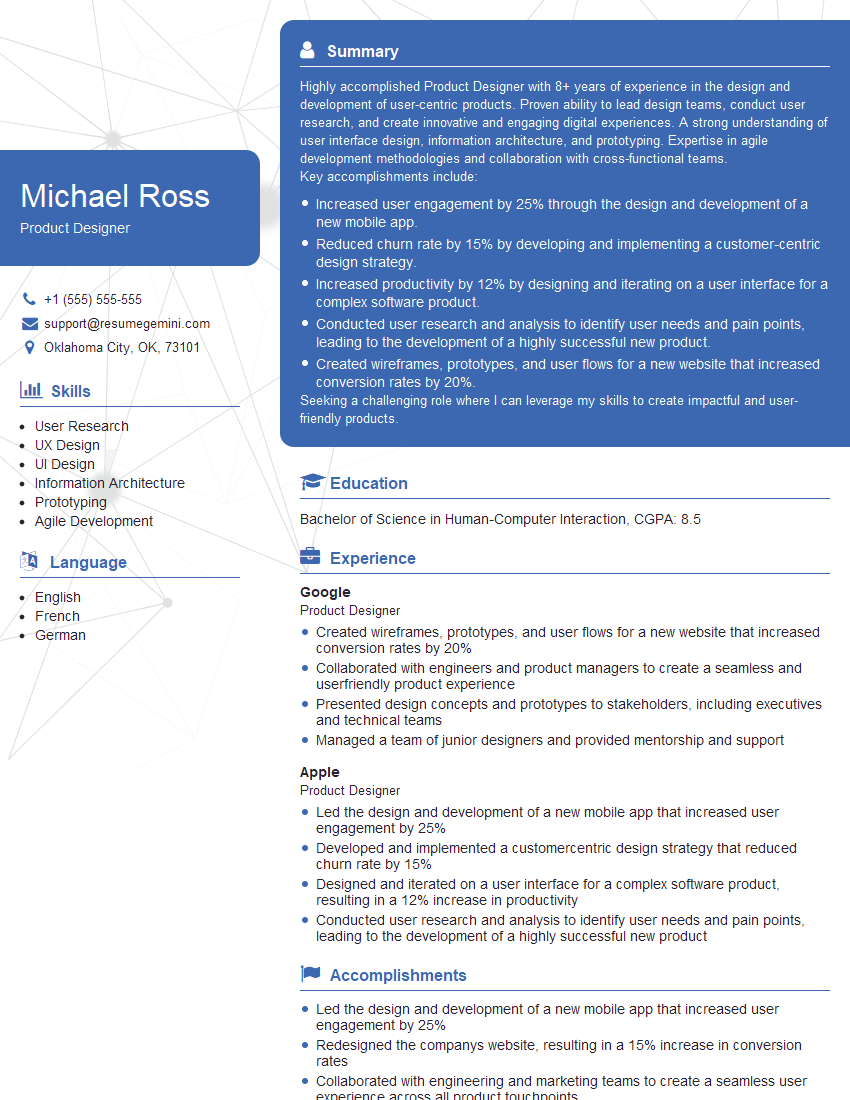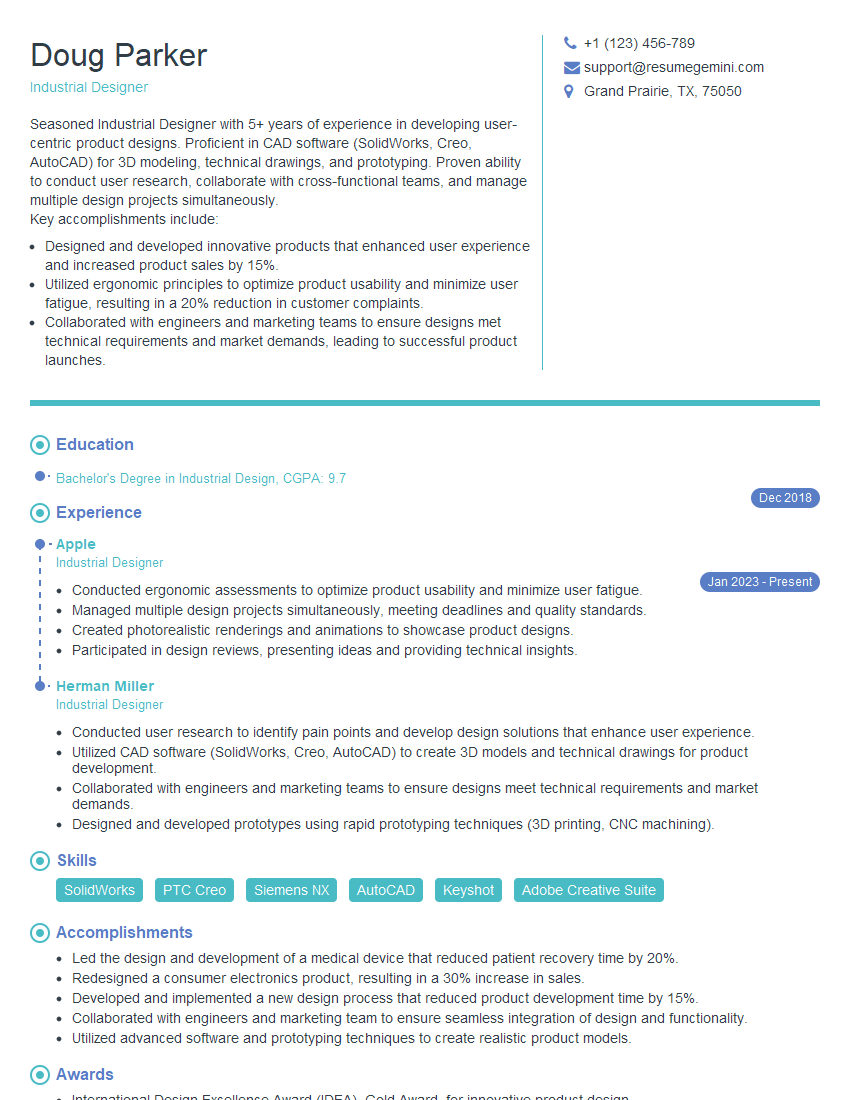The thought of an interview can be nerve-wracking, but the right preparation can make all the difference. Explore this comprehensive guide to ISO 11764-2 Ergonomics of Human-System Interaction – Part 2: Principles for Human-Centred Design interview questions and gain the confidence you need to showcase your abilities and secure the role.
Questions Asked in ISO 11764-2 Ergonomics of Human-System Interaction – Part 2: Principles for Human-Centred Design Interview
Q 1. Explain the core principles of ISO 11764-2: Human-Centred Design.
ISO 11764-2’s core principle is Human-Centred Design (HCD). It emphasizes placing the needs, capabilities, and limitations of the end-user at the heart of every design decision. This isn’t just about making things look nice; it’s about ensuring the system is effective, efficient, and satisfying for the people who will use it. This involves understanding the user’s context, tasks, and goals to create a system that truly fits their needs, rather than forcing the user to adapt to the system.
- Understanding user needs: Thoroughly researching and defining what users need to achieve with the system.
- Iterative design process: Continuously testing and refining the design based on user feedback.
- Usability testing: Evaluating the usability of the system through observations and feedback.
- Accessibility: Ensuring the system can be used by people with diverse abilities and needs.
For example, designing a medical device requires understanding the needs of both the medical professional and the patient. The device must be efficient for the professional to use, but also easy and comfortable for the patient. HCD ensures this balance.
Q 2. Describe the iterative design process as it relates to ISO 11764-2.
The iterative design process in ISO 11764-2 is cyclical and involves continuous improvement based on user feedback. It’s not a linear process, but rather a continuous loop of design, prototype, test, and redesign. Imagine building a house – you wouldn’t just build it based on initial blueprints; you’d make adjustments based on the builder’s experience, material availability, and even weather conditions. It’s the same with designing systems.
- Understanding the need: Defining the problem and the user’s needs.
- Concept development: Brainstorming and generating various design concepts.
- Prototyping: Creating low-fidelity prototypes to test and iterate quickly.
- User testing: Evaluating prototypes with users to gather feedback.
- Design refinement: Refining the design based on user feedback from testing.
- Implementation: Developing the final product.
- Evaluation: Assessing the effectiveness of the final system.
Each iteration refines the design, addressing usability issues and enhancing the user experience. This iterative approach ensures that the final product aligns closely with the user’s needs and expectations. For instance, designing a mobile app might involve several rounds of testing with users to improve navigation, functionality, and overall experience.
Q 3. How do you apply user research methods to inform design decisions based on ISO 11764-2?
User research methods are crucial for informing design decisions in HCD. They provide insights into user needs, behaviors, and context. Several methods can be employed, depending on the research question and project stage.
- Surveys: Gathering quantitative data on user preferences and demographics.
- Interviews: Conducting in-depth conversations to understand users’ needs and experiences.
- Usability testing: Observing users interacting with the system to identify usability issues.
- Contextual inquiry: Observing users in their natural environment to understand their work practices.
- Cognitive walkthroughs: Simulating users’ cognitive processes to identify potential usability problems.
For example, while designing a website for elderly users, I might conduct interviews to understand their technological literacy and visual impairments. This information would then inform the design of a user-friendly interface with large fonts and clear navigation.
Q 4. What are the key usability heuristics according to ISO 11764-2 and how do they guide design?
While ISO 11764-2 doesn’t explicitly list heuristics like Nielsen’s 10 usability heuristics, the principles implicitly guide design towards similar goals. Key aspects include:
- Learnability: The ease with which users can learn to use the system.
- Efficiency: The speed and accuracy with which users can perform tasks.
- Memorability: The ease with which users can remember how to use the system after a period of not using it.
- Errors: The frequency and severity of user errors, and the ease of recovering from errors.
- Satisfaction: The overall pleasantness of using the system.
- Accessibility: The ability for users with disabilities to use the system.
For instance, designing a self-service kiosk requires considering learnability (clear instructions), efficiency (quick transaction times), and error prevention (clear error messages). These usability heuristics are not explicitly stated but implicitly guide the design toward a user-friendly and effective system.
Q 5. Explain the importance of considering user needs and context in design based on ISO 11764-2.
Considering user needs and context is paramount in HCD. It’s about understanding the ‘who’, ‘what’, ‘when’, ‘where’, and ‘why’ of user interaction. The design must not only meet the user’s functional needs but also align with their physical, cognitive, and emotional capabilities within their specific environment.
- Physical context: Considering the physical environment where the system will be used (e.g., lighting, noise levels, temperature).
- Cognitive context: Considering the user’s cognitive abilities, knowledge, and experience.
- Social context: Considering the social environment where the system will be used (e.g., collaboration, social interaction).
- Organizational context: Considering the organizational structures, processes, and culture.
For example, designing a control panel for a power plant necessitates understanding the high-pressure environment, the operator’s expertise, and the potential consequences of errors. The design must be robust, intuitive, and minimize risks.
Q 6. How do you assess the effectiveness of a design using ISO 11764-2 principles?
Assessing design effectiveness involves a multi-faceted approach, combining quantitative and qualitative data. This ensures a comprehensive understanding of how well the design meets its intended goals.
- Usability testing: Measuring task completion times, error rates, and user satisfaction.
- Surveys: Gathering feedback on user satisfaction and perceived usability.
- Heuristic evaluation: Assessing the design against established usability principles.
- A/B testing: Comparing different design versions to determine which performs better.
- Data analytics: Analyzing usage data to identify patterns and areas for improvement.
For instance, after launching a new e-commerce website, analyzing website traffic, conversion rates, and customer feedback provides crucial data to evaluate its effectiveness and identify areas for optimization.
Q 7. Describe your experience in conducting user testing and analysis.
I have extensive experience conducting user testing and analysis, employing various methods to gather rich, actionable insights. My approach is highly iterative, often starting with formative research (e.g., interviews, contextual inquiry) to understand user needs before moving to summative evaluations (e.g., usability testing) to assess the design’s effectiveness.
In a recent project for a financial institution, we conducted moderated usability testing sessions with a diverse group of users, observing their interactions with a newly designed online banking platform. We recorded sessions, collected verbal feedback, and analyzed task completion times and error rates. The analysis revealed several usability issues, leading to design refinements that significantly improved the platform’s ease of use. For example, we found that the placement of a key button caused significant confusion, which we addressed by relocating it. We also used eye-tracking technology in some sessions to gather even more detailed data on user attention and focus.
My analysis goes beyond simple metrics; I look for patterns, understand the ‘why’ behind user behaviors, and create detailed reports that inform design decisions. This ensures that our designs are not only functional but also provide a positive and engaging user experience.
Q 8. How do you incorporate user feedback into the design iteration process?
Incorporating user feedback is paramount to human-centered design, as defined in ISO 11764-2. We don’t just gather feedback; we actively integrate it throughout the design iteration process. This is achieved through a structured approach that includes several stages.
- Early-stage feedback: We conduct user interviews and contextual inquiries to understand user needs and pain points *before* design even begins. This helps us establish a firm foundation based on real-world experiences.
- Mid-stage feedback: Usability testing with prototypes (low-fidelity sketches, clickable wireframes, etc.) allows us to identify usability issues early. We observe users interacting with the design, noting areas of confusion or frustration. Think of it as a dress rehearsal before the launch.
- Post-release feedback: Even after launching a product, we continue gathering feedback through surveys, user forums, and analytics. This helps us identify areas for improvement in subsequent updates or iterations. Continuous improvement is key.
We analyze the feedback using qualitative and quantitative methods, prioritizing critical issues based on their impact and frequency. This iterative process ensures that the final design aligns with user expectations and needs, making the product more efficient and enjoyable to use.
Q 9. How do you balance user needs with technical constraints in the design process?
Balancing user needs and technical constraints is a constant juggling act in design. ISO 11764-2 emphasizes the importance of finding a balance that prioritizes usability without sacrificing feasibility. We approach this challenge through a collaborative process involving designers, engineers, and other stakeholders.
We start by defining user requirements and creating user personas to represent different user groups. We then map these needs against the technical limitations (budget, technology, time, etc.). This often involves prioritizing features. For instance, a feature that offers high usability but requires significant development time might be prioritized over a less crucial one that’s technically simpler.
We frequently use trade-off analysis, weighing the usability benefits of a design against its technical complexity or cost. This may involve exploring alternative solutions or simplifying the design to meet the constraints while still achieving a satisfactory user experience. Think of it as negotiating a compromise that satisfies both sides.
Compromise doesn’t mean sacrificing user needs entirely; it means finding creative solutions. We might explore different technologies, streamline processes, or even redefine certain user requirements to achieve a harmonious design that’s both user-friendly and technically feasible.
Q 10. Describe a time you identified and resolved a usability issue using ISO 11764-2 principles.
During the design of a medical device control panel, usability testing revealed users struggled with the placement and labeling of emergency stop buttons. The buttons were small, clustered, and poorly labeled, failing to comply with ISO 11764-2 guidelines on clear, unambiguous controls.
Applying the principles of ISO 11764-2, we analyzed the problem, considering factors such as user reach, visibility, and cognitive load. The solution involved:
- Relocating the buttons: Moving them to a more accessible and visible location.
- Increasing button size: Enhancing their size for easy manipulation, particularly with gloved hands.
- Improving labeling: Using clear, concise, and universally understood symbols and text (considering colorblindness).
- Adding tactile feedback: Incorporating raised edges or textured surfaces for improved tactile identification.
After these changes, the usability testing showed a significant improvement in task completion time and error rates, demonstrating the positive impact of applying ISO 11764-2 principles.
Q 11. Explain your understanding of accessibility and inclusive design.
Accessibility and inclusive design are crucial aspects of human-centered design as highlighted by ISO 11764-2. Accessibility focuses on ensuring that people with disabilities can access and use a product or service. Inclusive design takes this a step further, creating designs that are usable and enjoyable by *everyone*, regardless of their abilities or background.
Accessibility considers various disabilities, including visual, auditory, motor, and cognitive impairments. Inclusive design broadens this perspective, taking into account age, cultural background, and other aspects of diversity. It’s about designing for the widest possible range of users, rather than just focusing on a specific segment.
A simple example: Consider a website with text-only content. While accessible to screen readers for visually impaired users, it might exclude users who learn best visually. Inclusive design would provide both textual and visual information, catering to diverse learning styles.
Q 12. How do you ensure that your designs meet accessibility standards?
Ensuring designs meet accessibility standards requires a multi-faceted approach. We use a combination of strategies:
- Following accessibility guidelines: We adhere to standards like WCAG (Web Content Accessibility Guidelines) and Section 508 (U.S. federal accessibility standards), which provide specific criteria for accessible design.
- Employing accessibility testing tools: We utilize automated testing tools to identify potential accessibility issues in our designs.
- Conducting accessibility audits: Regular audits are performed by trained accessibility specialists, to evaluate the product’s compliance with accessibility standards.
- Involving users with disabilities: We actively involve people with disabilities in the design and testing process. Their feedback provides invaluable insights that ensure the product actually serves their needs.
- Using assistive technology: We test our designs with various assistive technologies (screen readers, alternative input devices, etc.) to identify any potential usability barriers.
Accessibility isn’t an afterthought; it’s integral to the design process from the beginning. This approach makes the product more usable for everyone and minimizes the risk of legal and reputational issues.
Q 13. Describe your familiarity with different user interface design patterns.
My familiarity with user interface design patterns is extensive. I’m proficient in a variety of patterns, including:
- Navigation patterns: Breadcrumbs, mega-menus, tabs, accordions – for efficient site navigation.
- Input patterns: Date pickers, auto-complete suggestions, sliders – for seamless data entry.
- Feedback patterns: Progress bars, loading indicators, error messages – for clear communication with the user.
- Layout patterns: Grid systems, card layouts, hero sections – for organizing and presenting content effectively.
- Interaction patterns: Tooltips, drag-and-drop interfaces, modal dialogs – for intuitive user interaction.
The choice of pattern depends on the specific context and user needs. Choosing the right pattern enhances usability and ensures a consistent user experience across the application or website. For example, using a consistent navigation pattern throughout a website promotes learnability and reduces cognitive load for users.
Q 14. What are the key differences between usability testing and user research?
While both usability testing and user research are crucial to human-centered design, they differ significantly in their scope and objectives.
Usability testing is a specific method that focuses on evaluating the ease of use and effectiveness of a specific design or prototype. It involves observing users interacting with the design to identify usability issues and measure user performance. Usability testing is usually done later in the design process, with a relatively smaller group of participants.
User research is a broader field encompassing various methods to understand user needs, behaviors, and motivations. It can involve user interviews, surveys, contextual inquiry, ethnographic studies, and more. User research is often conducted early in the design process to inform design decisions and ensure the product solves the right problems.
In essence: usability testing is a *method* to assess a *design*, while user research is a broad *field* that informs the *design* process itself.
Think of it this way: user research is like exploratory work, helping you understand the terrain. Usability testing is like testing a specific path built on that terrain, checking if it’s easy to navigate.
Q 15. How do you create user personas and scenarios?
Creating effective user personas and scenarios is crucial for human-centered design, as mandated by ISO 11764-2. A persona is a fictional representation of a typical user, based on research and data. A scenario describes a specific interaction the user might have with the system. We build these through a combination of techniques:
- User Research: This involves conducting interviews, surveys, focus groups, and usability testing to gather data about real users. For example, I might interview potential users of a new medical device to understand their needs, workflows, and technical proficiency.
- Data Analysis: We analyze collected data to identify patterns and common characteristics among users. This helps in defining distinct user groups and their needs. For example, we might find that elderly users require larger fonts and simpler instructions.
- Persona Creation: Based on the research, we create detailed personas, including demographics, goals, motivations, frustrations, and technological skills. A persona might be named ‘Sarah,’ a 65-year-old retired teacher with limited computer experience, needing a medication reminder system.
- Scenario Development: We develop scenarios that illustrate how a persona would interact with the system. A scenario for Sarah might be: ‘Sarah needs to set a reminder for her daily medication. She opens the app, but is unsure how to navigate the interface.’ This helps visualize potential challenges.
By creating realistic personas and scenarios, we can ensure our design is truly user-centric and meets the needs of our target audience.
Career Expert Tips:
- Ace those interviews! Prepare effectively by reviewing the Top 50 Most Common Interview Questions on ResumeGemini.
- Navigate your job search with confidence! Explore a wide range of Career Tips on ResumeGemini. Learn about common challenges and recommendations to overcome them.
- Craft the perfect resume! Master the Art of Resume Writing with ResumeGemini’s guide. Showcase your unique qualifications and achievements effectively.
- Don’t miss out on holiday savings! Build your dream resume with ResumeGemini’s ATS optimized templates.
Q 16. How do you measure the success of a design based on user experience metrics?
Measuring the success of a design based on user experience (UX) metrics is essential for iterative improvement. ISO 11764-2 emphasizes the importance of measurable outcomes. We use both qualitative and quantitative metrics:
- Quantitative Metrics: These are measurable data points. Examples include:
- Task Completion Rate: Percentage of users successfully completing a task.
- Error Rate: Number of errors users make during task completion.
- Task Time: Time taken by users to complete a task.
- System Usability Scale (SUS): A standardized questionnaire measuring overall system usability.
- Qualitative Metrics: These provide insights into user experiences. Examples include:
- User Interviews: Gathering feedback on user satisfaction and pain points.
- Usability Testing Observations: Observing user behavior during interaction with the system.
- Feedback Surveys: Gathering user opinions on specific design aspects.
By combining these data types, we gain a comprehensive understanding of user experience and identify areas for improvement. For instance, a high error rate might indicate a design flaw requiring immediate attention.
Q 17. What are some common user interface design errors, and how can they be avoided?
Common user interface design errors often stem from a lack of focus on user needs and cognitive abilities. Some examples are:
- Poor Information Architecture: Information is not organized logically, making it difficult for users to find what they need. Solution: Use clear navigation menus, logical grouping of content, and sitemaps.
- Inconsistent Design: Elements such as buttons, fonts, and colors are not consistent throughout the interface. Solution: Establish and adhere to a comprehensive style guide.
- Lack of Feedback: Users don’t receive clear feedback when they interact with the system. Solution: Provide visual cues, confirmation messages, and progress indicators.
- Poor Error Handling: Error messages are unclear or unhelpful. Solution: Design user-friendly error messages that provide clear instructions on how to resolve the issue.
- Ignoring Accessibility Guidelines: The design is not accessible to users with disabilities. Solution: Adhere to WCAG guidelines (Web Content Accessibility Guidelines).
Avoiding these errors requires a thorough understanding of usability principles, user testing, and iterative design processes. The ISO 11764-2 standard strongly emphasizes preventing these issues through early user involvement and rigorous testing.
Q 18. Describe your experience with design tools and software (e.g., Figma, Sketch, Adobe XD).
I have extensive experience with various design tools, including Figma, Sketch, and Adobe XD. My choice of tool depends on the project’s specifics and team preferences.
- Figma: I frequently use Figma for its collaborative features, allowing real-time design collaboration among team members. Its vector-based editing ensures scalability and crisp visuals.
- Sketch: I’ve used Sketch extensively for its streamlined interface, ideal for quick prototyping and iteration. Its plugin ecosystem enhances productivity.
- Adobe XD: I utilize Adobe XD for its robust prototyping capabilities, especially when creating interactive prototypes for user testing. Its integration with other Adobe Creative Suite applications streamlines the design workflow.
Proficiency in these tools allows me to create high-fidelity prototypes, user flows, and design systems, ensuring consistent and efficient design processes. My expertise extends beyond the tools themselves; I understand how to leverage each tool’s strengths to optimize the design process.
Q 19. How do you manage competing priorities and deadlines in a design project?
Managing competing priorities and deadlines requires a structured approach. I use several strategies:
- Prioritization Matrix: I use a matrix (e.g., Eisenhower Matrix) to categorize tasks based on urgency and importance, allowing me to focus on high-impact tasks first.
- Agile Methodology: Working in an agile environment (see answer 7) inherently involves prioritizing tasks within sprints, enabling flexibility and adaptation to changing requirements.
- Time Blocking: I allocate specific time blocks for focused work on critical tasks, minimizing distractions.
- Communication: Open and proactive communication with stakeholders is essential to manage expectations and re-prioritize as needed.
- Scope Management: Clearly defining project scope at the outset helps avoid feature creep and ensures realistic deadlines.
A recent project involved balancing the needs of multiple stakeholders with tight deadlines. By using a prioritization matrix and daily stand-up meetings, we successfully delivered a functional prototype within the timeframe.
Q 20. How do you communicate design concepts effectively to stakeholders?
Effective communication is paramount. I use various methods to convey design concepts to stakeholders:
- Visual Communication: I use mockups, wireframes, prototypes, and design specifications to illustrate design decisions.
- Storytelling: I use narratives to explain the design rationale and its impact on users.
- Presentations: I create concise presentations that highlight key design elements and their benefits.
- User Testing Feedback: I share user testing findings to demonstrate the impact of design choices on user experience.
- Interactive Prototypes: I provide interactive prototypes that let stakeholders experience the design directly.
For example, when presenting a redesign of a company website, I used A/B testing results to show the positive impact on key performance indicators (KPIs) like conversion rates, illustrating the value proposition of the design changes.
Q 21. Describe your experience working in an agile development environment.
I have significant experience working in agile development environments. The iterative nature of agile aligns perfectly with human-centered design principles.
- Sprint Planning: I participate actively in sprint planning, helping to define design tasks and user stories for each sprint.
- Daily Stand-ups: I attend daily stand-up meetings to provide updates, identify roadblocks, and collaborate with developers.
- Design Reviews: I conduct regular design reviews to gather feedback from stakeholders and team members.
- User Testing and Feedback Integration: I integrate user testing feedback into the design process throughout the sprints.
- Continuous Improvement: I embrace the agile principle of continuous improvement, iteratively refining designs based on user feedback and testing results.
In a recent project using Scrum, we utilized daily stand-ups and sprint reviews to ensure seamless collaboration between designers, developers, and stakeholders. This resulted in a significantly more user-friendly product than would have been possible using a traditional waterfall approach.
Q 22. How familiar are you with different types of user interface design guidelines (e.g., Material Design, iOS Human Interface Guidelines)?
My familiarity with user interface design guidelines extends beyond a basic understanding; I have practical experience applying principles from various systems. Material Design, with its emphasis on bold typography, grid-based layouts, and responsive design, is a key framework I’ve used for Android development. Similarly, I’m proficient in Apple’s Human Interface Guidelines (HIG), focusing on its focus on simplicity, clarity, and platform consistency for iOS and macOS applications. Beyond these two dominant players, I’m also familiar with other design systems, such as Google’s Flutter framework and various design language guidelines for specific organizations. Understanding these guidelines is crucial for creating interfaces that are both visually appealing and intuitive to users.
For instance, when designing a mobile app, I might utilize Material Design’s components like bottom navigation bars for efficient navigation if the target platform is Android, while employing iOS HIG’s tab bars for similar functionality on iOS devices. The goal is always user experience optimization based on established platform conventions.
Q 23. How do you ensure that the design is compatible with various devices and platforms?
Ensuring design compatibility across diverse devices and platforms requires a multi-pronged approach. Responsive design is fundamental – this means the interface adapts seamlessly to different screen sizes and resolutions. This often involves using flexible layouts and CSS media queries (@media (max-width: 768px) { ... }) to adjust elements. Additionally, I leverage cross-platform development frameworks (like React Native or Flutter) to create single codebases adaptable to both iOS and Android. This greatly reduces development time and ensures consistency while still allowing platform-specific tweaks where necessary to adhere to each platform’s guidelines.
Testing on various devices and browsers is crucial. This involves using emulators, simulators and real-world testing on a range of hardware to identify and address any compatibility issues early on. Consideration must also be given to accessibility – using appropriate ARIA attributes for assistive technologies, ensuring sufficient contrast ratios, and supporting keyboard navigation are vital for broad accessibility across users and devices.
Q 24. What is the role of prototyping in the human-centered design process?
Prototyping plays a pivotal role in human-centered design, serving as a bridge between initial concepts and the final product. It allows for iterative testing and refinement, ensuring the design aligns with user needs and expectations *before* significant resources are invested in development. Prototypes provide tangible representations of the design, enabling stakeholders and users to experience and provide feedback on the proposed interface early in the design process. This iterative feedback loop significantly reduces the risk of costly rework later in the development cycle.
For example, I once worked on a project where initial wireframes (low-fidelity prototypes) revealed critical usability issues, prompting significant design adjustments before proceeding to high-fidelity prototypes. This saved weeks of development and significantly improved the final product.
Q 25. Describe different types of prototypes and their applications.
Prototypes exist along a spectrum of fidelity, from low-fidelity to high-fidelity. Low-fidelity prototypes (e.g., paper sketches, wireframes) are quick and cheap to create, focusing on fundamental structure and workflow. They’re ideal for initial concept exploration and gathering early feedback. High-fidelity prototypes (e.g., interactive mockups created with tools like Figma or Adobe XD) closely resemble the final product in terms of visual design and functionality. These are used for more detailed user testing, identifying specific usability problems and refining the user experience.
- Paper Prototypes: Quick, inexpensive, and excellent for early brainstorming and user feedback.
- Wireframes: Low-fidelity digital representations focusing on layout and information architecture.
- Interactive Prototypes: High-fidelity prototypes simulating real user interactions, often used for detailed usability testing.
Choosing the right prototype depends on the project stage and goals. Early stages benefit from quick, low-fidelity prototypes, while later stages require more detailed, high-fidelity versions.
Q 26. How do you conduct cognitive walkthroughs to evaluate usability?
Cognitive walkthroughs are usability evaluation methods where evaluators simulate users’ thought processes as they navigate a system. It’s a form of expert review, not direct user testing, focusing on understanding the cognitive steps required to complete tasks within the interface. The walkthrough involves a structured approach, with evaluators stepping through tasks and asking questions about each step:
- What is the user’s goal?
- What action should the user take?
- Will the user see that action as the best option?
- Once the action is taken, will the user understand the system’s response?
By systematically working through each step, the walkthrough identifies potential points of confusion or difficulty, highlighting areas where the design needs improvement. For example, a cognitive walkthrough might reveal that a critical button is poorly labeled or positioned, making it difficult for users to find and understand its function.
Q 27. How would you address a design challenge where conflicting user needs exist?
Conflicting user needs are common in design, requiring careful consideration and trade-offs. The key is to understand the underlying reasons for the conflict and explore solutions that balance competing priorities. This often involves:
- User Research: Deeper investigation into the reasons behind the conflicting needs. Why do users want conflicting features? Are there underlying unmet needs?
- Prioritization: Rank user needs based on importance and frequency. Which needs are most crucial for the system’s success?
- Compromise & Iteration: Explore design solutions that address as many needs as possible, potentially offering alternative pathways or settings to cater to different user preferences.
- Persona Development: Create user personas to represent different user groups and their needs. This can help to understand the context of conflicting requirements and to make more informed decisions.
For example, a mobile banking app might face conflicting needs: some users prioritize simplicity, while others require advanced features. A solution might be to offer a streamlined interface for basic transactions while providing a separate section for advanced features, allowing users to customize their experience based on their needs.
Q 28. How do you stay updated on current trends and best practices in UX/UI and human factors?
Staying current in UX/UI and human factors requires continuous learning. I achieve this through a combination of methods:
- Following Industry Publications: I regularly read publications like UX Collective, Nielsen Norman Group articles, and Interaction Design Foundation blogs. These resources provide insights into the latest research and best practices.
- Attending Conferences and Workshops: Participating in industry events allows networking and learning from experts, providing a deeper understanding of emerging trends.
- Online Courses and Tutorials: Platforms like Coursera and Udemy offer courses covering various aspects of UX/UI design and human factors. I regularly take advantage of these to learn new skills and deepen my knowledge.
- Professional Networks: Engaging with online communities and attending meetups helps me stay connected with peers and share knowledge.
Continuous learning is vital for any UX professional, ensuring designs remain relevant, user-friendly, and aligned with the ever-evolving technological landscape.
Key Topics to Learn for ISO 11764-2 Ergonomics of Human-System Interaction – Part 2: Principles for Human-Centred Design Interview
- Understanding Human Capabilities and Limitations: Explore the physiological and psychological aspects influencing human performance in system interaction. Consider factors like physical strength, cognitive load, and perceptual limitations.
- Human-Centered Design Process: Master the iterative design process, encompassing user research, prototyping, testing, and evaluation based on ISO 11764-2 principles. Be prepared to discuss your experience with user-centered design methodologies.
- Applying Ergonomic Principles: Discuss practical applications of ergonomic principles, such as workspace design, interface design, and task analysis, to optimize user interaction and minimize risk of injury or error.
- Usability and User Experience (UX): Understand how usability testing and UX principles contribute to a positive and efficient user experience. Be ready to discuss your understanding of different usability testing methods.
- Risk Assessment and Mitigation: Explain how ergonomic risk assessments are conducted and how identified hazards are mitigated through design solutions. This includes understanding the hierarchy of controls.
- Accessibility and Inclusivity: Discuss the importance of designing systems that are accessible to users with diverse abilities and needs. This may involve considering assistive technologies and inclusive design principles.
- Collaboration and Communication: Highlight your ability to collaborate with diverse teams (designers, engineers, users) and communicate complex ergonomic concepts effectively.
- Case Studies and Examples: Prepare examples from your experience demonstrating your application of ISO 11764-2 principles in real-world projects.
Next Steps
Mastering ISO 11764-2 is crucial for career advancement in fields demanding human-centered design expertise. It demonstrates your commitment to creating safe, efficient, and user-friendly systems. To significantly boost your job prospects, create an ATS-friendly resume that highlights your relevant skills and experience. ResumeGemini is a trusted resource to help you build a professional and impactful resume that showcases your expertise in ISO 11764-2. We provide examples of resumes tailored to this specific standard to help guide you.
Explore more articles
Users Rating of Our Blogs
Share Your Experience
We value your feedback! Please rate our content and share your thoughts (optional).
What Readers Say About Our Blog
good
